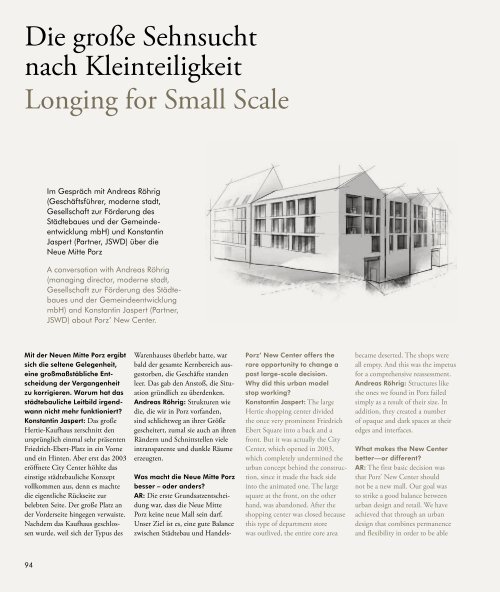JSWD — Ensembles
ISBN 978-3-86859-477-5
ISBN 978-3-86859-477-5
You also want an ePaper? Increase the reach of your titles
YUMPU automatically turns print PDFs into web optimized ePapers that Google loves.
Die große Sehnsucht<br />
nach Kleinteiligkeit<br />
Longing for Small Scale<br />
Im Gespräch mit Andreas Röhrig<br />
(Geschäftsführer, moderne stadt,<br />
Gesellschaft zur Förderung des<br />
Städtebaues und der Gemeindeentwicklung<br />
mbH) und Konstantin<br />
Jaspert (Partner, <strong>JSWD</strong>) über die<br />
Neue Mitte Porz<br />
A conversation with Andreas Röhrig<br />
(managing director, moderne stadt,<br />
Gesellschaft zur Förderung des Städtebaues<br />
und der Gemeinde entwicklung<br />
mbH) and Konstantin Jaspert (Partner,<br />
<strong>JSWD</strong>) about Porz’ New Center.<br />
Mit der Neuen Mitte Porz ergibt<br />
sich die seltene Gelegenheit,<br />
eine großmaßstäbliche Entscheidung<br />
der Vergangenheit<br />
zu korrigieren. Warum hat das<br />
städtebauliche Leitbild irgendwann<br />
nicht mehr funktioniert?<br />
Konstantin Jaspert: Das große<br />
Hertie-Kaufhaus zerschnitt den<br />
ursprünglich einmal sehr präsenten<br />
Friedrich-Ebert-Platz in ein Vorne<br />
und ein Hinten. Aber erst das 2003<br />
eröffnete City Center höhlte das<br />
einstige städtebauliche Konzept<br />
vollkommen aus, denn es machte<br />
die eigentliche Rückseite zur<br />
belebten Seite. Der große Platz an<br />
der Vorderseite hingegen verwaiste.<br />
Nachdem das Kaufhaus geschlossen<br />
wurde, weil sich der Typus des<br />
Warenhauses überlebt hatte, war<br />
bald der gesamte Kernbereich ausgestorben,<br />
die Geschäfte standen<br />
leer. Das gab den Anstoß, die Situation<br />
gründlich zu überdenken.<br />
Andreas Röhrig: Strukturen wie<br />
die, die wir in Porz vorfanden,<br />
sind schlichtweg an ihrer Größe<br />
gescheitert, zumal sie auch an ihren<br />
Rändern und Schnittstellen viele<br />
intransparente und dunkle Räume<br />
erzeugten.<br />
Was macht die Neue Mitte Porz<br />
besser – oder anders?<br />
AR: Die erste Grundsatzentscheidung<br />
war, dass die Neue Mitte<br />
Porz keine neue Mall sein darf.<br />
Unser Ziel ist es, eine gute Balance<br />
zwischen Städtebau und Handels-<br />
Porz’ New Center offers the<br />
rare opportunity to change a<br />
past large-scale decision.<br />
Why did this urban model<br />
stop working?<br />
Konstantin Jaspert: The large<br />
Hertie shopping center divided<br />
the once very prominent Friedrich<br />
Ebert Square into a back and a<br />
front. But it was actually the City<br />
Center, which opened in 2003,<br />
which completely undermined the<br />
urban concept behind the construction,<br />
since it made the back side<br />
into the animated one. The large<br />
square at the front, on the other<br />
hand, was abandoned. After the<br />
shopping center was closed because<br />
this type of department store<br />
was outlived, the entire core area<br />
became deserted. The shops were<br />
all empty. And this was the impetus<br />
for a comprehensive reassessment.<br />
Andreas Röhrig: Structures like<br />
the ones we found in Porz failed<br />
simply as a result of their size. In<br />
addition, they created a number<br />
of opaque and dark spaces at their<br />
edges and interfaces.<br />
What makes the New Center<br />
better<strong>—</strong>or different?<br />
AR: The first basic decision was<br />
that Porz’ New Center should<br />
not be a new mall. Our goal was<br />
to strike a good balance between<br />
urban design and retail. We have<br />
achieved that through an urban<br />
design that combines permanence<br />
and flexibility in order to be able<br />
94


















